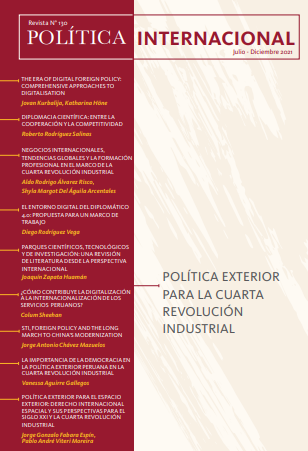Parques científicos, tecnológicos y de investigación: una revisión de literatura desde la perspectiva internacional
DOI:
https://doi.org/10.61249/pi.vi130.30Palabras clave:
parques científicos, tecnológicos y de investigación, política regional de innovación, nuevas empresas de base tecnológica, vinculación academia-industria, desarrollo económicoResumen
En un mundo complejo e incierto caracterizado por múltiples fenómenos en curso varios países han optado por un renovado impulso a las políticas científicas, tecnológicas y de innovación. A nivel subnacional se ha venido implementando parques científicos, tecnológicos y de investigación (parques CTI) principalmente en las regiones de Norteamérica, Europa Occidental y Asia del Este. Si bien los grupos de interés que hacen viable los parques CTI determinan en buena medida los objetivos que se persiguen, se ha podido notar que por lo general dichos parques coinciden en tres objetivos: i) el fomento de nuevas empresas de base tecnológica, ii) la transferencia de tecnología entre la academia e industria y, iii) la contribución al crecimiento económico local y nacional. Adicionalmente, no existe una definición universalmente aceptada sobre lo que es un parque CTI y, por lo tanto, las diversas clasificaciones propuestas constituyen un reflejo de los intentos por dilucidar cuándo y bajo qué condiciones los parques son efectivos para las empresas inquilinas y el desarrollo económico regional. Se han identificado al menos siete lecciones aprendidas de los parques CTI, de las cuales destacan la inexistencia de un único modelo de parque, la necesidad de contar con una visión a largo plazo, la importancia de un liderazgo en la administración del parque y la necesidad de un financiamiento público continuo con participación privada. Finalmente, existe cierto consenso en la literatura revisada para considerar a los parques CTI como parte de un conjunto de herramientas de políticas regionales de innovación que tienen la misión de impulsar el desarrollo económico, social y tecnológico de los países.
Descargas
Bibliografía
Aiginger, K. (2007). Industrial policy: A dying breed or a re-emerging phoenix. Journal of Industry, Competition and Trade, 7 (3-4), 297-323. https://doi.org/10.1007/s10842-007- 0025-7.
Albahari, A. (2019). Heterogeneity as a key for understanding science and technology park effects. En S. Amoroso, A. Link, y M. Wright (Eds.),Science and technology parks and regional economic development: An international perspective (pp.143-157). Palgrave Macmillan. https://doi.org/10.1007/978-3-030-30963-3_9.
Amoroso, S. y Hervás, F. (2019). An international perspective on science and technology parks. En S. Amoroso, A. Link, y M. Wright (Eds.), Science and technology parks and regional economic development: An international perspective (pp. 1-8). Palgrave Macmillan. https://doi.org/10.1007/978-3-030-30963-3_1.
Annerstedt, J. (2006). Science parks and high-tech clustering. En P. Bianchi y S. Labory (Eds.), International handbook on industrial policy (pp. 279-297). Edward Elgar Publishing. https://doi.org/10.4337/9781847201546. 00023
Barbaroux, P. (2013). Spin-off. En E. Carayannis (Ed.). Encyclopedia of creativity, invention, innovation, and entrepreneurship (1era ed., pp. 1722-1727). Springer-Verlag New York. https://doi.org/10.1007/978-1-4614-3858-8_240
Bigliardi, B., Dormio, A.I., Nosella, A. y Petroni, G. (2006). Assessing science parks’ performances: Directions from selected Italian case studies. Technovation, 26 (4), 489- 505. https://doi.org/10.1016/j.technovation.2005.01.002
Cadorin,E., Klofsten, M., Löfsten,H.(2021). Science parks, talent attraction and stakeholder involvement: An international study. The Journal of Technology Transfer, 46 (1), 1-28. https://doi.org/10.1007/s10961-019-09753-w
Castells, M. y Hall, P. (1994). Technopoles of the world: The making of 21st century industrial complexes. Routledge.
Comisión Económica y Social de las Naciones Unidas para Asia y el Pacífico. (2019). Establishing science and technology parks: A reference guidebook for policymakers in Asia and the Pacific. United Nations Publication. https://repository.unescap.org/bitstream/handle/20.500.12870/114/Guidebook_Final.pdf?sequence=1&isAllowed=y
Edler, J. y Georghiou, L. (2007). Public procurement and innovation - Resurrecting the demand side. Research Policy, 36 (7), 949-963. https://doi.org/10.1016/j.respol.2007.03.003
Feldman, M. (2016). Geography of innovation. En M. Augier y D. Teece (Eds.), The Palgrave encyclopedia of strategic management (pp.625-630). Palgrave Macmillan. https://doi.org/10.1057/978-1-137-00772-8_537
Hall, P. (2011). Regions and regional policy : A global view. En H.W. Richardson, C.-H.C. Bae y S.-C. Choe (Eds.), Reshaping regional policy (pp. 21-40). Edward Elgar Publishing.
Hanel, P. (2015). Externalités de R-D. En J. Prud’homme, P. Doray, y P. Bouchard (Eds.), Sciences, technologies et sociétés de A à Z. (pp. 101-103). Les Presses Universitaires de Montréal. https://pum.umontreal.ca/catalogue/sciences-technologies-et-societes-dea-a-z/fichiers/d6d088ff-221b-4128-8310-a79dc09826ff/9782760634961.pdf
Hansson, F., Husted, K., Vestergaard, J. (2005). Second generation science parks: From structural holes jockeys to social capital catalysts of the knowledge society. Technovation, 25 (9), 1039-1049. https://doi.org/10.1016/j.technovation.2004.03.003
Hassink, R. y Berg, S.H. (2014). Regional innovation support systems and technopoles. En D.S. Oh y F. Phillips (Eds.), Technopolis: Best practices for science and technology cities (pp. 43-65). Springer. https://doi.org/10.1007/978-1-4471-5508-9_3
Hassink,R. y Hu, X. (2012). From specialisation to diversification in science and technology parks. World Technopolis Review, 1(1), 6-15. https://doi.org/10.7165/wtr2012.1.1.6
Henriques, I.C., Sobreiro, V.A, Kimura, H. (2018). Science and technology park: Future challenges. Technology in Society, 53, 144-160. https://doi.org/10.1016/j. techsoc.2018.01.009
Hsinchu Science Park (2020). An introduction to the Hsinchu Science Park. Recuperado el 25 de Octubre del 2020, de https://www.s i p a . g o v . t w / e n g l i s h / h o m e . j s p ? s e r n o = 2 0 1 0 0 3 2 1 0 0 1 4 & m s e r n o = 201003210003&menudata=EnglishMenu&contlink=content/introduction_1.js p&level2=Y
Hobbs, K., Link, A. y Scott, J. (2017). Science and technology parks: An annotated and analytical literature review. The Journal of Technology Transfer, 42 (4), 957-976. https://doi.org/10.1007/s10961-016-9522-3
International Association of Science Parks and Areas of Innovation (s.f.). Our industry: Definitions. Recuperado el 30 de Septiembre del 2019, de https://www.iasp.ws/ourindustry/definitions
Jiménez-Moreno, J.J., Martínez-Cañas,R., Ruiz-Palomino,P. y Saéz-Martínez,F.J. (2013). The role of science and technology parks in the generation of firm level social capital through university - firm relations: An empirical study in Spain. En J. Ferreira, M.Raposo, R. Rutten y A. Varga, (Eds.), Cooperation, clusters, and knowledge transfer: Universities and firms towards regional competitiveness (pp.19-34). Springer. https://doi.org/10.1007/978-3-642-33194-7_2
Kang, B.J. (2017). Role and policies of STP in the era of 4th industrial revolution from triple helix viewpoint. World Technopolis Review, 6(2), 90-101. https://doi.org/10.7165/WTR17S1207.17
Komninos, N. (2008). Intelligent cities and globalisation of innovation networks. Routledge. https://doi.org/10.4324/9780203894491
Lecluyse, L., Knockaert, M. y Spithoven, A. (2019). The contribution of science parks: A literature review and future research agenda. The Journal of Technology Transfer, 44 (2), 559–595. https://doi.org/10.1007/s10961-018-09712-x
Lecluyse, L. y Spithoven, A. (2019). Toward a framework to advance the knowledge on science park contribution: An analysis of science park heterogeneity. En S. Amoroso, A. Link, y M. Wright (Eds.), Science and technology parks and regional economic development: An international perspective (pp. 185-209). Palgrave Macmillan. https://doi.org/10.1007/978-3-030-30963-3_11
Link, A. y Scott, J. (2006). U.S. university research parks. Journal of Productivity Analysis, 25 (1-2), 43-55. https://doi.org/10.1007/s11123-006-7126-x
Link, A. y Scott, J. (2007). The economics of university research parks. Oxford Review of Economic Policy, 23 (4), 661-674. https://doi.org/10.1093/oxrep/grm030
Link, A. y Scott, J. (2015). Research, science and technology parks: Vehicles for technology transfer. En A. Link, , D. Siegel, y M. Wright, (Eds.), The Chicago handbook of university technology transfer and academic entrepreneurship (pp. 168-187). University of Chicago Press.https://doi.org/10.7208/chicago/9780226178486.003.0006
Luggen, M. (2004). A concept for technology and innovation management in start-ups and new technology-based firms (NTBF): PockeTM. Innovation: Management, Policy & Practice, 6 (3), 458-467. https://doi.org/10.5172/impp.2004.6.3.458
Lund, E. (2019). The strategic choices that science and technology parks must make. En S. Amoroso, A. Link, y M. Wright (Eds.), Science and technology parks and regional economic development: An international perspective (pp. 9-24). Palgrave Macmillan. https://doi.org/10.1007/978-3-030-30963-3_2
Massey,D. y Wield, D. (1992). Evaluating science parks. Local Economy, 7 (1), 10-25. https://doi.org/10.1080/02690949208726126
McCarthy, I., Silvestre, B., Von Nordenflycht, A. y Breznitz,S. (2018). A typology of university research park strategies: What parks do and why it matters. Journal of Engineering and Technology Management, 47, 110-122. https://doi.org/10.1016/j.jengtecman.2018.01.004
Mora-Valentín, EM., Ortiz-de-Urbina-Criado, M. y Nájera-Sánchez, J.J. (2018). Mapping the conceptual structure of science and technology parks. The Journal of Technology Transfer, 43 (5), 1410-1435. https://doi.org/10.1007/s10961-018-9654-8
Nahm, K.B. (2000). The evolution of science parks and metropolitan development. International Journal of Urban Sciences, 4 (1), 81-95. https://doi.org/10.1080/12265934.2000.9693465
Nauwelaers, C., Kleibrink, A. y Ciampi Stancova, K. (2014). The role of science parks in smart specialisation strategies. Technical Report by the Joint Research Centre of the European Commission. https://s3platform.jrc.ec.europa.eu/en-US/web/guest/w/therole-of-science-parks-in-smart-specialisation-strategies
Nauwelaers, C., Kleibrink, A. y Ciampi Stancova, K. (2019). Science parks and placebased innovation. En S. Amoroso, A. Link, y M. Wright (Eds.), Science and technology parks and regional economic development: An international perspective (pp. 75-98). Palgrave Macmillan. https://doi.org/10.1007/978-3-030-30963-3_6
Nawaz, W. y Koç, M. (2020). Industry, university and government partnerships for the sustainable development of knowledge-based society: Drivers, models and examples in US, Norway, Singapore and Qatar. Springer Nature. https://doi.org/10.1007/978-3-030-26799-5
Ng, W.K.B., Appel-Meulenbroek, R., Cloodt, M. y Arentze, T. (2019). Towards a segmentation of science parks: A typology study on science parks in Europe. Research Policy, 48 (3), 719-732. https://doi.org/10.1016/j.respol.2018.11.004
Ng, W.K.B., Junker,R., Appel-Meulenbroek, R.,Cloodt, M. y Arentze, T. (2020). Perceived benefits of science park attributes among park tenants in the Netherlands. The Journal of Technology Transfer. 45 (4), 1196-1227. https://doi.org/10.1007/s10961-019-09744-x
National Research Council. (2009). Understanding research, science and technology parks: Global best practices: Report of a symposium. The National Academies Press. https://doi.org/10.17226/12546
Organización de las Naciones Unidas para el Desarrollo Industrial. (2018). Strategic framework for leveraging a new generation of industrial parks and zones for inclusive and sustainable development. United Nations Industrial Development Organization. https:// www.unido.org/sites/default/files/files /2019-12/UNIDO_Strategic%20Framework_WEB.pdf
Organización de las Naciones Unidas para el Desarrollo Industrial.(2021). A new generation of science and technology parks. United Nations Industrial Development Organization. https://hub.unido.org/sites/default/files/ publications/STP_MODULE_2021.pdf
Organización de las Naciones Unidas para la Educación, la Ciencia y la Cultura. (2017). Science and technology park governance: Concept and definition. Recuperado el 25 de Noviembre del 2020, de http://www.unesco.org/new/en/natural-sciences/sciencetechnology/university-industry-partnerships/science-and-technology-parkgovernance /concept-and-definition/
Organización para la Cooperación y el Desarrollo Económicos. (2011). Regions and innovation policy. OECD Publishing. https://doi.org/10.1787/ 9789264097803-en
Organización para la Cooperación y el Desarrollo Económicos. (2013). Regions and innovation: Collaborating across borders. OECD Publishing. https://doi.org/10.1787/9789264205307-en
Phan, P.H., Siegel, D. y Wright, M. (2005). Science parks and incubators: Observations, synthesis and future research. Journal of Business Venturing, 20 (2), 165-182. https://doi.org/10.1016/j.jbusvent.2003.12.001
Poonjan, A. y Tanner, N. (2020). The role of regional contextual factor for science and technology parks: A conceptual framework. European Planning Studies, 28 (2), 400-420. https://doi.org/10.1080/09654313.2019.1679093
Research Triangle Park. (2019). About RTP. Recuperado el 5 de Noviembre del 2019, de https://www.rtp.org/
Rodríguez-Pose, A. y Hardy, D. (2014). Technology and industrial parks in emerging countries: Panacea or pipedream? Springer International Publishing. https://doi.org/10.1007/978-3-319-07992-9
Saxenian, A. (1996). Regional advantage: Culture and competition in Silicon Valley and Route 128. Harvard University Press.
Schwab, K. (2016). The fourth industrial revolution. World Economic Forum.
Siegel,D., Westhead,P. y Wright, M. (2003). Science parks and the performance of new technology-based firms: A review of recent U.K. evidence and an agenda for future research. Small Business Economics, 20 (2), 177-184. https://doi.org/10.1023/A:1022268100133
Stanford Research Park (s.f.). Mission statement. Recuperado el 25 de Octubre del 2019, de https://stanfordresearchpark.com/about
Taş, N. (2019,11-12 Junio). Industrial parks: Inclusive and sustainable industrial development [keynote presentation]. International Conference on Industrial Parks for Inclusive and Sustainable Industrial Development, Lima, Peru. https://www.unido.org/sessions-day1
The American Association of University Research Parks (s.f.). What is a Research Park/Innovation District? Recuperado el 30 de Septiembre del 2019, de https://www.aurp.net/what-is-a-research-park
The United Kingdom Science Park Association (s.f.). Our sector. Recuperado el 30 de Septiembre del 2019,de http://www.ukspa.org.uk/our-sector
Tuspark (2019). Tuspark. Recuperado el 5 de Noviembre del 2019, de http://en.tusholdings.com/h%20/tuspark/
Van Geenhuizen, M, Soetanto, D. y Scholten,V. (2012). Science parks: Changing roles and changing approaches in their evaluation. En Van Geenhuizen, M. y Nijkamp, P. (Eds.). Creative knowledge cities: Myths, visions and realities (pp. 135-156). Edward Elgar Publishing. https://doi.org/10.4337/9780857932853.00012
Warwick, K. (2013). Beyond industrial policy: Emerging issues and new trends. OECD Publishing. http://dx.doi.org/10.1787/5k4869clw0xp-en
West, J. (2018). Open innovation. En M. Augier y D. Teece (Eds.), The Palgrave encyclopedia of strategic management (pp.1157-1162). Palgrave Macmillan. https://doi.org/10.1057/978-1-349-94848-2_199-1
Westhead, P. y Batstone, S. (1999). Perceived benefits of a managed science park location. Entrepreneurship and Regional Development: An International Journal, 11(2), 129-154. https://doi.org/10.1080/089856299283236
Wright, M., Link, A. y Amoroso, S. (2019). Lessons learned and a future research and policy agenda on science parks. En S. Amoroso, A. Link, y M. Wright (Eds.), Science and technology parks and regional economic development: An international perspective (pp. 211-219). Palgrave Macmillan. https://doi.org/10.1007/978-3-030-30963-3_12
Wright, M. y Westhead, P. (2019). Science technology parks and close relations:Heterogeneity, context and data. En S. Amoroso, A. Link, y M. Wright (Eds.), Science and technology parks and regional economic development: An international perspective (pp.39-60). Palgrave Macmillan. https://doi.org/10.1007/978-3-030-30963-3_4
Zhang, Y. (2005). The science park phenomenon: Development, evolution and typology. International Journal of Entrepreneurship and Innovation Management, 5 (1-2), 138-154. https://doi.org/10.1504/IJEIM.2005.006341
Descargas
Publicado
Cómo citar
Número
Sección
Licencia
Derechos de autor 2023 Joaquín Zapata Huamán

Esta obra está bajo una licencia internacional Creative Commons Atribución 4.0.








